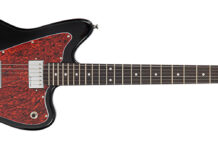Introducing Polyphia, Rising Stars of the Instrumental Guitar Scene
Polyphia’s most recent song and video, for their 2016 track “Lit,” kicks off in a manner similar to that of many instrumental shred bands—with the camera showing the group’s two guitarists, Tim Henson and Scott LePage, simultaneously picking out a twisty, fleet-fingered repeating harmony lick high up on the necks of their guitars.
But within seconds, the tune veers off into unusual territory—the percussion track lights up with electronic burbles, twinkling keyboards and sampled sounds poke through the mix, and the guitars are chopped and cut with EDM-style hiccups. Visually, meanwhile, a young man who is the focal point of the video dances along to the almost poppy rhythm as various shapes and colors radiate off his body.
All the while, Henson and LePage, who, in the clip at least, look like they’d be more at home in a new-millennium boy band than a metal-tinged instrumental act, rip out virtuosic runs and solos full of lightning-fast licks, whammy bar flutters and liquid harmony lines. It’s an unusual approach to shred, though one that has over the last few years led the Texas-based outfit to become one of the sub-genre’s brightest new stars.
To date, Polyphia, which also currently includes bassist Clay Gober and drummer Clay Aeschliman, have racked up millions of YouTube views for their various videos and guitar playthrough clips and shared stages with the likes of Periphery, Animals As Leaders, Between the Buried and Me and August Burns Red.
They’ve also released two full-length albums, 2014’s Muse and 2016’s Renaissance, that, in terms of the bright, often major-key melodies and slippery, cleanly picked shred lines, recall the sort of sound made famous by players like Joe Satriani and, at times, Steve Vai. At the same time, in the music’s incorporation of decidedly non-rock elements, in particular hip-hop, pop and EDM, it sounds not quite like anything else in the shred universe today.
As for how the very young band (Henson and LePage formed Polyphia in high school in 2010) came upon their sound, LePage says it’s merely a natural outgrowth of their musical interests.
“The main goal for us is just to have fun,” he explains. “We want to make music that sounds like the music we love, which is hip-hop and pop and all that stuff, and do it with the guitar. Tim’s main influences are Jimi Hendrix and stuff like that. And I’m super into Stevie Ray Vaughan. So we certainly have our pentatonic-scale guitar-player influences. And then we’re trying to put that together with the whole world of hip-hop and electronic-based music. Because we think both of those things are cool as fuck, you know?”
That said, Henson stresses, “It’s not that we’re consciously trying to bring this style of guitar playing into these other types of music. It’s more like, ‘This is what we do.’ This is the kind of music we want to make at this point in time, but we’ve been doing music all our lives.” Henson has in fact been doing music for more or less his whole life. Growing up in the Dallas suburb of Plano, Texas, he began playing violin at the age of three. “But I hated it,” he says with a laugh. “My mom forced it on me and I did not like it at all.”
At 10, his father introduced him to guitar. “My dad had played a little bit, and he pulled one out and I was like, ‘Wow, that’s really cool.’ I asked if I could try it. I’d thought since I could play violin I’d be really good at guitar, but I was terrible! But I decided that was what I wanted to do, because I thought rock music was way cooler than classical. And from there I pretty much spent every second, from 10 to 15 years old, doing nothing but playing guitar.”
LePage, who also grew up in Plano, started at the same age. “My dad also played guitar,” he recalls, “and when I was 10 I remember watching him one day, just shredding and making cool sounds, and thinking, I wanna do that. After that, I would wait for him to come home from work so he could teach me songs. After a while I would try to figure them out on my own, by ear.”
To this last point, both Henson and LePage are for the most part self-taught, a fact that, given how advanced their abilities were at such young ages, is unusual, to say the least. Both claim, however, that it just came down to spending a lot of time woodshedding. “I would just play CDs and click the rewind button and try to figure out the notes,” LePage says. “I started off with the Black Sabbath album Paranoid, learning every song off the album by ear. It’s an easier one to do that with because it’s mostly pentatonic. But it really helped me paint a picture in my head of the shapes that they use, and I was able to figure everything out a lot easier. That started me on the path of getting into this whole world.”
Henson, for his part, also had a particular non-musical impetus behind his guitar development. “I was a problem child, and I ended up on probation for most of high school for two possessions,” he says with a laugh. “Because we live in Texas, and weed is not cool there. So I had a strict curfew, and I had nothing to do but play guitar.” As for what led the two of them down the shred-guitar path?
“I don’t really know,” Henson admits. “It’s funny because that whole style, it’s not really the kind of music I enjoy listening to now. But at the time, I mean, every kid wants to play fast. It’s like, ‘Look at this skill I attained and all the things I can do!’ ” For Henson, his indoctrination into shred began with Paul Gilbert.
“I had one of his DVDs, the one where he’s dressed up like an astronaut [2006’s Spaceship Live]. I took a couple things from that. And then I got turned on to Steve Vai and the virtuosos. From there I discovered Guthrie Govan, and I became pretty much the biggest Guthrie fanboy. That I guess accounts for a lot of the things I started playing in Polyphia.”
The fact that Henson was playing this type of music in high school was all the more uncommon given the fact that another teenager, LePage, was living in the same town and doing the same thing.
“Everybody always tells us it’s so crazy,” LePage says. “I literally live five minutes down the street from Tim, and I grew up going to school with the guy. It’s funny though because we didn’t really start playing guitar together until my junior year. I always knew he was a sick guitarist but we never really played music together until mutual friends linked us up. But once they did, that was it. We just connected so perfectly.” When Henson and LePage initially formed Polyphia, however, it was to pursue a sound that was markedly different from the one they have today.
“We were both really into death metal and deathcore,” Henson says. “We loved Whitechapel. Within the Ruins. Oceano. Heavy shit like that. And that was the first Polyphia sound—pretty much just shredding the entire time.” That sound can be heard on Polyphia’s initial 2011 demo, Resurrect, recorded when LePage was 18 and Henson just 17. The four-song offering is jam-packed with insanely acrobatic shredding and loopy lead and harmony lines, all of it played over grinding, downtuned riffs and rapid-fire blast-beat drumming.
The sound, LePage says, was like “pretty much anything that would be on the Summer Slaughter Tour type of stuff.” Initially, however, the young band wasn’t sure exactly how to fully realize their style. At one point early on, they even added vocals to Resurrect, partly in an effort to land a slot on the roster of one of their favorite metal labels, Sumerian.
“Sumerian was our dream record label at the time,” Henson says. “We played a festival with another Sumerian band who liked our music, and they said, ‘We’re gonna tell our label to check you out. What’s your email?’ So Sumerian hit us up, and we were so stoked. But we opened it and literally all it said was: Where’s the singer? So we were like, ‘Fuck, guess we need a singer…’ ”
Polyphia did in fact create a version of Resurrect that featured both clean and harsh vocals, but it proved an uneasy fit for the music.
“So right before we released the music we took all the vocals off and put the EP out that way,” LePage says. From there, Polyphia’s road forward as an instrumental act was set, even as their sound was just beginning its evolution. The band’s next recording, the 2013 EP Inspire, found them moving away from the manic deathcore sound of their earliest days to something that was still heavy and chunky, yet infinitely more melodic. One track from that album, “Impassion,” also served as their breakthrough single of sorts, after the band decided to post a guitar playthrough video that displayed every run, sweep and dive-bomb in up-close, high-def quality, to YouTube to accompany the track. To date, the clip has more than two million views.
“We did that because that was the thing to do at the time,” Henson says matter-of-factly. “We went to this spot in Dallas’ art district that is just a really cool-looking place, and we brought our guitars and a laptop and cameras and filmed the playthrough in public, in front of everybody. And we got a lot of traction on YouTube from it. People really liked the aesthetic of the video—even though it was total DIY.”
It was with Polyphia’s next recording, the 2014 full-length Muse, that they truly grew into the sound they’re known for today, incorporating elements of pop, funk, electronic music and other styles into their shred-guitar framework. Songs like “Champagne,” “Sweet Tea” and “James Franco” explode with vibrant, insanely catchy hooks and upbeat melodies, and are wrapped in a crisp production that lends the music a sleek, almost futuristic vibe.
Says LePage, “Around that time we didn’t really want to play fast, shreddy metal anymore. We started getting into radio songs, and that opened up this whole new world to us, like, ‘Everything on the radio is catchy and sticks in my head…whether I or anybody thinks it’s good or not!’ We wanted to get away from the whole, ‘Let’s just get on the record and shred as hard as we can’ kind of thing.”
As for what sort of music the guys were getting into? “I discovered Drake,” Henson says simply. “And to this day, right now, I listen to Drake every day. I know every lyric to every song. So it was Drake and rap and hip-hop and just generally things on the radio. In fact, that’s where most of the songs on Muse come from. They’re based on popular songs from 2014 that were on the radio. We’d pick out favorites and try to write over them.”
As an example, Henson points to the standout Muse track “Champagne.” “That song is based on [New Orleans R&B and hip-hop artist] August Alsina’s ‘I Luv This Shit,’ ” he explains. “I remember hearing that on the radio for the first time and it just blew my mind, because the way it was structured was verse/pre-chorus/chorus/post-chorus. I’d never heard something like that. I just thought it was so amazing the way it builds all this tension just to release it into a chorus, and then do it again with a post-chorus. It’s just hook after hook after hook. So we pretty much wrote over this rap song and then stripped the rap song and put bass and drums to it. And it’s really fun, because when you play that song and you play the guitar part from ‘Champagne’ over it, it lines up perfectly.”
Another way in which Polyphia drew inspiration from hip-hop on Muse was in their use of guest guitarists, which mimicked the way rap tracks are packed full of guest verses. To help out on various songs, the band tapped everyone from Intervals’ Aaron Marshall (“Sweet Tea”) and Chon’s Mario Camarena (“Baditude”) to solo shredder Nick Johnston (“Champagne”) and ex–Chelsea Grin shredder Jason Richardson (“Aviator”).
Says Henson, “We were like, ‘Let’s make this like a rap album and feature all our favorite guitarists!” The band pulled back on the guest appearances for their second and most recent full-length, 2016’s Renaissance, while continuing to plow even further ahead in terms of exploring non-rock sounds. So much so that these days LePage says, “We’re kinda closer to the whole pop side of things than metal.”
As for the fact that many people still tend to think of them as a metal band, he continues, “It’s kind of funny, because we’re similar enough to be grouped in with that type of music but we’re different enough to where nobody knows what tour to put us on. Because we’re not metal anymore. At least not like we used to be.” “A lot of times with us it depends what era of the band people are listening to,” Henson says. “Like, some of them go, ‘Oh, yeah, Polyphia’s a djent band.’ But they’re talking about the Inspire era.”
He laughs. “Or they’ll say, ‘Polyphia’s such poppy bullshit!’ But they’re definitely talking about Muse and the more recent stuff.” This stylistic adventurism has often led to confusion about just what type of band Polyphia really is. While they’re often lumped in with acts like Animals As Leaders, Chon, Intervals and the like, the fact that they’re so young, that they embrace more modern pop styles, and that they don’t exactly look like a metal or shred act has resulted in some negative reactions from fans of the genre.
To that last point, Henson says, “I guess we kind of asked for it. When we first started it was like, ‘We can appeal to musicians with our music, but we want girls to like us, too!’ ” So we cared about how we looked. And maybe we were really dumb to do that. Because sometimes people don’t even comment on our music. It’s only, ‘You guys look bad. I hate you.’ ” But on this next release I don’t think we’re going to focus on any image at all. Because it’s irrelevant. It’s just about the music and that’s all that matters.” As far as the next release, Polyphia are currently holed up at a Detroit studio putting the finishing touches on an EP due later this year. And for fans who may have felt the EDM touches of last year’s “Lit” were a step too far, be prepared.
“We have songs on this upcoming EP that are straight-up hip-hop,” LePage says. “Just rap beats with guitars over it.” Adds Henson, “We brought in a few electronic and hip-hop producers, guys like Y2K. So there’s a lot of really cool shit going on with electronics and how we’re using them with real drums and bass and guitar to make something that I would say is very unique. And the shit bumps. I keep saying the words ‘party banger’ when I describe the songs, because I just picture people at parties going off to them.” When it comes to continuing to develop and push the boundaries of their sound, LePage says that he views it as a necessary component of being a musician. “If you like a bunch of different styles of music, why just stick to one?” he asks rhetorically.
“That just gets boring. We did the deathcore-type shred guitar music thing, we did the kind of groovy djent thing. We went through those phases. Then we tried the pop thing, and that was cool. It was like, ‘This is the sound we want to do because this is really fun music.’ And with the whole EDM thing, it’s music that’s developing so quickly. People are doing new shit every month. And we love that. We always want to be doing something different because that’s fun for us.”
As for what Polyphia hope to achieve going forward? “The most important thing is to feel fulfilled with the music,” Henson says. “But as far as achievements and things like that? I guess I want a Grammy. So that’s something to work toward. And I want to make music with my favorite artists. I definitely have it on my bucket list to make a song with Kanye. That would be legendary.” Henson pauses. “But, you know, I’m also aware that I’m saying these things to a guitar magazine…”
Polyphia Axology
GUITARS (Henson) Ibanez Prototype, Ibanez RG652AHM, Ibanez RG350M, Ibanez S5521Q , Ibanez RGAIX6FM, Ibanez RGDIX6MPB, Ibanez RG852, Ibanez RG920MQM, Fender American Elite Stratocaster, Fender American Rosewood Stratocaster; (LePage) Ibanez Prestige RG655m, Ibanez Prestige S5528LW, Ibanez Prestige S5470F, Ibanez Prestige RG2620Z, Ibanez Prototype, Ibanez SA
AMPS (Henson) Orange Dark Terror head, Orange PPC412 cabinet, Fractal Axe-Fx II; (LePage) Orange Dark Terror Amp head, Orange PPC412 cabinet, Fractal Axe-Fx II
Source: www.guitarworld.com








